Lesson 18.2: Natural Resources
Lesson 18.2: Natural Resources
Lesson Objectives
Distinguish between renewable and non-renewable resources.
List the major energy and material resources upon which humans depend.
Discuss the stresses increasing human consumption places on resource renewal.
Sequence the events which lead to the formation of fossil fuels.
Assess levels of depletion of non-renewable energy resources.
Analyze the ways in which technology and consumption result in overharvesting, pol- lution, atmospheric changes, and habitat loss.
Evaluate the effects of population growth on resource use and environmental pollution.
Relate inequalities in resource distribution to global political stability.
Compare the concept of sustainable use to that of renewable vs. nonrenewable re- sources.
Describe the nature and uses of soil resources.
Describe how human activities including technology affect ecosystem services such as
Soil generation
Waste disposal
Nutrient cycling
Recycling dead organic materials
Fertility of the land
Discuss effects of population growth, technology, and consumption on land and soil resources.
Relate soil erosion, pollution, and land development to ecosystem stability.
Connect soil erosion, pollution, and land development to global stability. www.ck12.org 904
Evaluate the effects of changes in these services for humans.
Review conflicts between agricultural technology, environment, and society.
Recognize tradeoffs required by nuclear power plants: reduced emissions vs. radioactive fuels and waste.
Analyze the ways in which humans have altered soil and land resources for other species.
Identify the extent of terrestrial ecosystem loss, and its effects on biodiversity.
Interpret the effects of soil pollution on biodiversity.
Describe how human activities including technology affect ecosystem services such as:
The hydrologic cycle
Waste disposal
Nutrient cycling
Evaluate the effects of changes in these services for humans.
Discuss the effects of population growth, technology, and consumption on water re- sources.
Explain the effects of overdrafting, pollution, and atmospheric changes on ecosystem stability.
Relate overdrafting and pollution to global stability.
Analyze the ways in which humans have altered water resources for other species.
Identify the extent of wetland loss, and its effects on biodiversity.
Interpret the effects of water pollution on biodiversity.
Introduction
Defining natural resources raises important philosophical questions.
“Resources” are useful or valuable. But are resources useful for and valuable to humans – or all life? If we “use” them, do we necessarily “consume” them? Is value limited to economics? Are resources limited to materials, or can they include processes, systems, and living things?
Definitions of “natural” go straight to the heart of our views about ourselves. Most definitions include a tension or conflict between the human and the non-human parts of the Earth: Anything that is natural is “not altered or disguised,” “not produced or changed artificially,” or, rather unhelpfully, “found in nature.” We often define nature as separate from humans: “the world of living things and the outdoors” or with elements of inner conflict (“a primitive state of existence, untouched and uninfluenced by civilization or artificiality”) or even religion (“humankind’s natural state as distinguished from the state of grace”).
It is not an idle exercise to think carefully about your own definition of natural resources, because such thinking can clarify your relationship and responsibilities to the Earth. Do natural resources exist only for humans to use (or “exploit” – a term repeated in many definitions)? Are we apart from nature, or a part of nature? In what ways are we similar to other species? How are we different? How do those similarities and differences help us to define our responsibilities to “nature” – to other species and our physical environment?
Historically, the concept of natural resources was intended as a measure of respect and appreciation for the materials Earth provided, and the supplies humans used and modified to develop the civilization in which they lived. Economic value was primary, and a list of natural resources would include energy sources such as coal or oil and raw materials such as iron or copper. Living things could be, but often were not added: fibers from plants, and skins from animals.
As use became exploitation and later depletion, we began to better appreciate our depen- dence on natural resources, as well as our power over them. Economist E.F. Schumacher, in a 1973 series of essays titled Small is Beautiful, suggested that our economy is unsustainable because natural resources (especially energy) can be depleted. He made the case that natural resources should be considered capital, rather than expendable – conserved, rather than sim- ply used. He also argued that nature’s capacity to resist pollution is limited, pointing to the value of whole ecosystems and ecosystem services. During the 1990s, ecological economist Robert Constanza calculated that “nature’s services” were worth $33 trillion per year – more than the $25 trillion total of the inter-human economy at that time. Although awareness of resource depletion and ecosystem services is increasing, their values remain inadequately recognized by our economy, and sustainability remains a goal for the future.
What definition for natural resources shall we use? On the Department of Energy’s “Ask a Scientist” website, Bob Hartwell defines a natural resource as “something supplied by nature which supports life on this planet.” This concise description includes most of the ideas we’ve discussed above, and views human use with an ecological perspective appropriate for the study of biology. Humankind is a part of nature, one species in an interdependent web which includes the Earth and all life. Without question, we are a unique species: we have the power to change that interdependent web in ways no other species can, we have the ability to learn about and understand the patterns and processes which maintain the web, and we have the responsibility to use our natural resources together with that understanding in ways which sustain the web – for our ourselves and for all life.
Most biologists today would probably classify ecosystems, their processes and “services,” and their species as natural resources, together with energy sources and materials from the environment. Biodiversity (which includes both species and ecosystems) is certainly a natural resource, according to this definition. In this sense, this entire chapter explores natural resources. The first lesson dealt with biodiversity as well as some of the ecosystem services which depend on biodiversity. This lesson will focus on energy, land and soil, and water resources. Because several unique problems (acid rain and ozone depletion, for example) apply to atmospheric resources, we will focus on the atmosphere in a third lesson. A final lesson will combine our concerns about the closely related issues of energy use and atmospheric change to focus on climate change. These lessons will by no means address all natural resources, but they should give you an overview of the complexities of and need for sustainable use, and provide you with some detailed insight into several major problems.
Renewable and Nonrenewable Resources: Energy and Sus- tainable Use
Applied to natural resources, renewable or non-renewable are relative rather than pre- cise terms. Not surprisingly, we use human parameters to classify resources into these two categories.
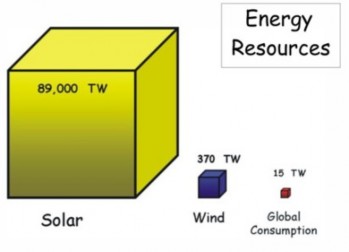
Figure 18.22: Solar radiation and wind energy are considered renewable resources because their availability far exceeds our rates of consumption. Here, availability is shown as volume equal to the annual flux in terawatts (1 TW = 1012 watts). Eighty-nine thousand TW represents the amount of sunlight that falls on the Earth’s surface, 370 TW depicts all the energy in the wind, and 15 TW was the global rate of energy consumption in 2004. (61)
A resource replenished by natural processes at a rate roughly equal to the rate at which humans consume it is a renewable resource. Sunlight and wind, for example, are in no danger of being used in excess of their longterm availability (Figures 18.22, 18.23). Hydropower is renewed by the Earth’s hydrologic cycle. Water has also been considered renewable, but overpumping of groundwater is depleting aquifers, and pollution threatens the use of many water resources, showing that the consequences of resource use are not always simple depletion. Soils are often considered renewable, but erosion and depletion of minerals proves otherwise. Living things (forests and fish, for example) are considered renewable because they can reproduce to replace individuals lost to human consumption. This is true only up to a point, however; overexploitation can lead to extinction, and overharvesting can remove nutrients so that soil fertility does not allow forest renewal. Energy resources derived from living things, such as ethanol, plant oils, and methane, are considered renewable, although their costs to the environment are not always adequately considered. Renewable materials would include sustainably harvested wood, cork, and bamboo as well as sustainably harvested crops. Metals and other minerals are sometimes considered renewable because they are not destroyed when they are used, and can be recycled.

Figure 18.23: Wind power is considered a renewable resource because the rate of supply far exceeds the rate of use (Figure 18.22). Although current use supplies less than 1% of the world’s energy needs, growth in harvesting wind energy is rapid, with recent annual increases of more than 30 percent. (53)
A non-renewable resource is not regenerated or restored on a time scale comparative to its consumption. Non-renewable resources exist in fixed amounts (at least relative to our time frame), and can be used up. The classic examples are fossil fuels such as petroleum, coal, and natural gas. Fossil fuels have formed from remains of plants (for coal) and phyto- and zoo-plankton (for oil) over periods from 50 to 350 million years. Ecologist Jeff Dukes estimates that 20 metric tons of phytoplankton produce 1 liter of gasoline! We have been consuming fossil fuels for less than 200 years, yet even the most optimistic estimates suggest that remaining reserves can supply our needs for
Oil: 45 years
Gas: 72 years
Coal: 252 years.
Nuclear power is considered a non-renewable resource because uranium fuel supplies are finite. Some estimates suggest that known economically feasible supplies could last 70 years at current rates of use - although known, and probably unknown reserves are much larger, and new technologies could make some reserves more useful.
Recall that the Second Law of Thermodynamics (which states that the entropy of an isolated system which is not in equilibrium will tend to increase over time) reinforces this view

of “renewable” and “non-renewable” resources: Energy flows downhill – gets used up, is transformed into heat; only materials that can be recycled are “renewable.” It is only our time scale which makes any form of energy renewable. Eventually, the sun will burn out, as well.
Population growth, industrialization of developing countries, and advances in technology are placing increasing pressures on our rates of consumption of natural resources. Pollution and overexploitation foreshadow resource depletion, habitat loss, and atmospheric change. Unequal distribution of wealth, technology, and energy use (Figure 18.25) suggest that developing nations will further increase demands on natural resources. With these increases in demand, current levels of resource use cannot be maintained into the future, and social and political instability may increase. Improvements in technology could mitigate these problems to some extent.
The concept of renewable vs. non-renewable resources clearly depends on rates of human use (Figure 18.24); less clearly, its usefulness depends on the effects of use on other natural resources, such as pollution. Of course, we could change our rates of consumption. Indeed, if we increase our rate of consumption, renewable resources may need to be reclassified as non- renewable. This is the foundation of the concept of sustainable use – use of resources at a rate which meets the needs of the present without impairing the ability of future generations to meet their needs. Notice that this concept continues to focus on human needs; however, a solid understanding of ecology recognizes that human needs depend on entire ecosystems,

which in turn depend on all species. Sustainable use could also apply to ecosystem services, which can be overwhelmed by overuse even though their “use” does not involve consumption. Perhaps we should shift our natural resource focus from rate of consumption (renewable vs. non-renewable) to sustainable use!
Soil and Land Resources
What negative connotations we give to soil resources in our daily conversation! Hands are “dirty;” clothing is “soiled.” Yet the formation of soils require thousands and even millions of years of physical, geological, chemical, and biological processes. Soil’s complex mixture of eroded rock, minerals, ions, partially decomposed organic material, water, air, roots, fungi, animals, and microorganisms supports the growth of plants, which are the foundation of terrestrial ecosystems (Figure 18.26). Soil is a balanced intersection of air, water, and land resources, sensitive to changes in any one element. We use soils for agriculture, gardening, landscaping, earth sheltered buildings, and to absorb waste from composting and septic drain fields. Peat, an accumulation of partially decayed plant material, can be burned for energy.
Soils can assimilate and remove low levels of contamination, thus it is useful for waste treat- ment. Not surprisingly, high levels of contamination can kill soil microorganisms, which help to accomplish this service. Toxics from industry, underground storage tanks, pesticide use, and leaching from landfills and septic tanks contaminate soils across the globe. Contami- nated soils endanger human and ecosystem health.
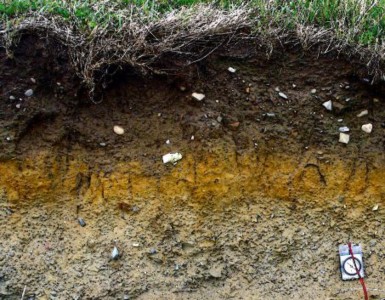
In 1980, after several years of health concerns and protests, the U.S. Government relocated and reimbursed 800 families from the Love Canal housing development built atop a landfill which had “disposed of” 22,000 tons of toxic waste from Hooker Chemical and Plastics Corporation. Increased awareness of the problems of abandoned toxic waste sites led to the passage later that year of Superfund legislation, which holds polluters accountable for effects of toxic waste, and taxes chemical and petroleum industries to pay for cleanup of sites where responsible parties cannot be identified. As of early 2007, the EPA listed 1,245 Superfund sites; 324 are delisted, and 66 new sites are proposed. In general, developing countries lag behind in identification, cleanup, and prevention.
Agriculture, as one of the largest land uses, has altered soils in a number of ways. When we harvest crops repeatedly from soil, we remove basic ions such as Calcium, Magnesium, Potassium, and Sodium. One result is acidification, which lowers soil fertility and produc- tivity. Acid rain and the use of nitrogen fertilizers accelerate acidification, and acid rain can increase soil contamination.
Irrigation can degrade soils through salination – the accumulation of salts. High concen- trations of salt make it difficult for plants to absorb water by osmosis, so salination reduces plant growth and productivity, and can lead to desertification (degradation of formerly productive land – usually at least semi-arid) and soil erosion.
Agriculture, deforestation, overgrazing, and development can remove vegetation to cause unnatural levels of erosion by wind and water. In the U.S., erosion forced its way into public awareness during the 1930s after drought compounded exposed soils. The famous Dust Bowl (Figure 18.27) resulted in the loss of at least 5 inches of topsoil from nearly 10 million acres of land and the migration of 2.5 million people out of the Great Plains. Today in the U.S., contour plowing, cover crops, terracing, strip farming, no-till farming, reforestation, and better construction practices prevent some soil erosion (Figure 18.28), but the USDA reports that 1.6 billion metric tons of topsoil were lost annually between 1997 and 2001. Since Great Plains agriculture began some 200 years ago, the U.S. has lost one-third of its topsoil. Alarming rates of slash-and-burn agriculture in tropical forests expose thin soils to erosion, and development in China sends 1.6 billion tons of sediment annually into the Yellow River.

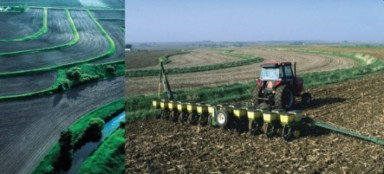
With – or sometimes without – its soil, land resources are used by humans for agriculture, forestry, mining, industry, waste disposal, and cities. Modification of land for these uses inevitably alters ecosystems, and in many cases, the resulting urban sprawl, pollution, sali- nation, erosion, and/or desertification lead to the loss of species, as well. As you learned in the lesson on biodiversity, habitat loss is the primary cause of extinction. Within the past 100 years, the area of land cultivated worldwide has increased 74%; grazing land increased 113%. Agriculture has cost the United States 50% of its wetlands and 99% of its tallgrass prairies. Land changes also result in fragmentation, yet another threat to biodiversity. Pres- sures from population growth cause the loss of land for human use, as well: ecologist David Pimental reports that erosion and salination destroy more than 2 million acres of prime agricultural land each year, and urban growth, transportation systems, and industry remove a million additional acres from production. Global increases in cropland and pasture from 1700 to 1990 are shown in Figure 18.29.
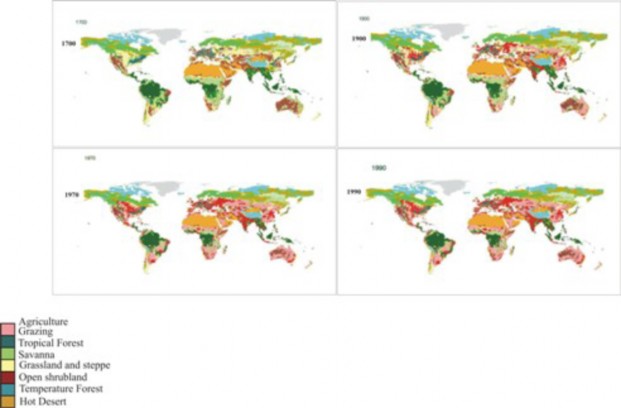
Land use changes affect global processes as well as the ecosystems they directly involve. Deforestation – even if it is replaced by agriculture – reduces photosynthesis, which means that less CO2 is removed from the atmosphere. The result is that CO2 builds up – and as you will see in the fourth lesson of this chapter, an increase in CO2 means an increase in the greenhouse effect and global warming. The International Panel on Climate Change (IPCC) estimates that land use change contributes 1.6 gigatons of carbon (as CO2) per year to the atmosphere. This is highly significant when compared to the better-known fossil fuel-burning carbon contributions of 6.3 gigatons. Urbanization and industry contribute to yet another land use issue that affects water re- sources and the atmosphere. Increasingly, impervious surfaces such as parking lots, building roofs, streets and roadways are covering land areas. Impervious surfaces prevent water infil- tration and groundwater recharge, increasing runoff and altering waterways. They deprive tree roots of aeration and water, decreasing productivity and increasing CO2. Far more than vegetated surfaces, they absorb solar radiation and convert it to heat, increasing runoff, which eventually degrades streams. In the U.S., impervious surfaces cover an area almost as large as the state of Ohio. Solutions to this harmful impact include the development of porous pavements and green roofs (Figure 18.30).
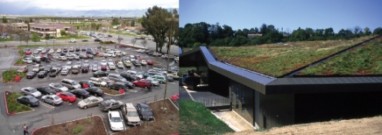
Figure 18.30: Impervious surfaces (left) fragment habitats, increase runoff, degrade water sources, reduce photosynthesis, and effectively increase CO2 in the atmosphere. In the U.S., they cover an area of land almost the size of Ohio. Permeable pavements and green roofs (right) are beginning to reverse their effects. (14)
Water Resources
At the intersection of land and water resources are wetlands: swamps, marshes and bogs whose soil is saturated (Figure 18.31). Historically, humans have viewed wetlands as wasted land; the U.S. has lost as much of 50% of its wetlands to agriculture, development, and flood control. Recently, wetland loss and the loss wetland species has taught us the importance of this ecosystem. Ecosystem services provided by wetlands include:
In the U.S., at least, recognition of the economic value and biodiversity of wetlands has led to restoration efforts and requirements for replacement of those lost through development.
The Ramsar “Convention on Wetlands of International Importance, especially as Waterfowl Habitat,” signed by 18 nations in 1971, works to conserve wetlands throughout the world for their ecological services and their economic, scientific, cultural, and recreational values. Signatories today number 157, and they meet every 3 years.
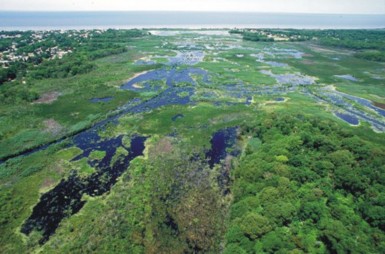
Water is the quintessential resource of life; its unique physical, chemical and biological prop- erties make it difficult for us to imagine life on any planet which lacks liquid water. For human use, however, water must be fresh. About 97% of Earth’s water is found in the oceans. Of the 3% which is fresh water, over 2/3 is locked in ice. The 1% which is fresh liquid water is mostly below ground, leaving just 0.3% as surface water in lakes and rivers (Figure 18.32). The atmosphere contains just .001%.
As industry, agriculture, development, and a growing world population use more water, fresh water supplies are shrinking due to over-drafting of groundwater and pollution of surface and groundwater. Over-drafting has lowered water tables in Texas, California, and India, leaving many wells dry. New Orleans is below sea level, and San Jose, California dropped 13 feet, because over-pumping caused the land to subside. The UN and others have labeled the current state of water resources throughout the world a Water Crisis (Figure 18.33). You might wonder why we don’t tap the oceans; the answer is that desalination is extremely costly in terms of energy and economics. The UN estimates that 1.1 billion people worldwide are without adequate fresh water, and that 2.6 billion lack enough water for sanitation to protect from disease. Water conflicts in the Middle East, Eastern Europe, and Korea have threatened regional political stability.
Water pollution, especially from nonpoint sources or runoff, threatens vital freshwater and marine resources in the U.S. and throughout the world. A single example dramatically
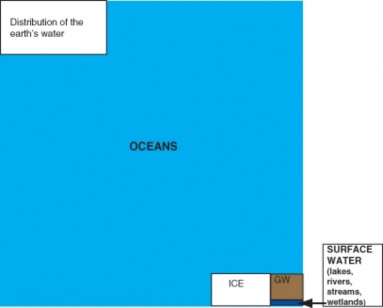
illustrates the potential for disruption of natural cycles and loss of biodiversity. Runoff of fertilizers applied to vast expanses of agricultural land and other sources such as wastewater have led to what ecologists say is a doubling of the amount of nitrogen available to plants and animals, and that amount could increase by another 60% by 2050. At first glance this may seem like a benefit to life, but it is not. Especially in aquatic ecosystems, excessive nutrients lead to overgrowth of algae, creating algal blooms. Some species are toxic in themselves, but more often, this eutrophication - literally, “feeding too well” - leads to such high levels of respiration (recall that photosynthesizers must respirate – especially at night!) that dissolved oxygen levels plummet, resulting in the death of fish and other species. Death results in decomposition and further nutrient input – compounding the problem. Eutrophication threatens one of the most diverse habitats on earth – coral reefs, which cover just 1% of the earth’s surface yet harbor 25% (over 4000) - of marine fish species. Adapted to low-nutrient environments and characterized by tight nutrient cycles, reefs in the pathway of excess nutrient runoff from agriculture and development become overgrown with algae, which block light from coral polyps. The Nature Conservancy predicts that 70% of Earth’s coral reefs will have disappeared by 2050 if current rates of destruction continue.
Among the most devastating consequences of eutrophication are at least 146 dead zones, where low oxygen levels caused by eutrophication have extinguished all ocean life. The most notorious extends into the Gulf of Mexico at the mouth of the Mississippi River, which brings fertilizer runoff from the U.S. corn belt (Figure 18.34). In July of 2007, this dead zone

covered an area of ocean the size of New Jersey and affected shrimp and fishing industries as well as countless species of marine organisms. Interestingly, a similar zone in the Black Sea disappeared between 1991 and 2001, after political changes in the Soviet Union and Eastern Europe made fertilizers too expensive to use for most agriculture. Unfortunately, most are growing, and the nitrogen cycle disruption affects many bodies of freshwater throughout the world, as well.
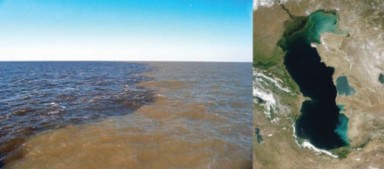
Conserving Water and Other Natural Resources
Can you imagine what the expression “virtual water” could mean? It is an important concept in the conservation of water resources.
Virtual water is the water used in the production of a good or service. Although it is no longer contained in the product, its use is a part of the cost of production, and as such should be factored into the product’s value. Here are some estimates of virtual water “contained” in various products, from the United Nations Education, Scientific, and Cultural Organization (UNESCO) Institute for Water Education:
The more water we use, the more likely we are to draw down wells and rivers beyond the hydrologic cycle’s power to recharge them. The more water we use, the more we are likely to pollute the 1% of Earth’s waters which are fresh (as well as the oceans). Protecting soils and
lands (especially wetlands and watersheds) is a critical part of protecting water resources, because the hydrologic cycle integrates terrestrial and aquatic ecosystems.
Thus, as for all conservation (wise use) or sustainable use (meeting needs of the present without impairing those of future generations), the first step is to reduce our use of water. This and other strategies to protect our water resources are summarized below. Don’t forget the list of what you can do as an individual, at the end of the lesson on biodiversity!
water storage and replenishment of aquifers
protection of coastlands from tides and storms
flood control
water purification I: slowing of water flow allows sedimentation to remove particulates
water purification II: denitrification of excess nutrients
rich habitat for wildlife
rich habitat for plants (30% of U.S. plant diversity)
recreation: hunting, fishing, ecotourism (e.g., The Everglades)
1 kg wheat:1,300 liters
1 kg beef:15,000 liters
1 pair of jeans: 10,850 liters
Reduce the use of water, and the abuse of soil, land, and wetlands.
Landscape with native, drought-resistant vegetation.
Use low-flow toilets, faucets, and showerheads. Check out possible local government subsidies for installing these water saving mechanisms.
Purchase foods from water-efficient crops which do not require irrigation.
Reuse water where appropriate.
Gray water, which has been used for laundry or washing, can be used to water gardens or flush toilets.
On a municipal level, sewage water can be used for fountains, watering public parks or golf courses, fire fighting, and irrigating crops that will be boiled or peeled before consumption.
Catch runoff, which will also slow non-point source pollution and erosion.
Place rainbarrels adjacent to buildings.
Recharge pits which will re-fill aquifers.
Support legislation that reduces pollution.
For example in the U.S., the 1977 Clean Water Act, through the EPA, regulates in- dustrial discharge of contaminants and sets standards for water quality.
Work locally, nationally and internationally to make clean fresh water available.
The United Nations Depart of Economic and Social Affairs has initiated a second Decade for Water for Life, 2005-2015 to increase awareness of water shortages and work toward sustainable use of freshwater resources.
The World Water Council unites 300 member organizations from 60 countries to work to “build political commitment and trigger action on critical water issues at all lev- els... to facilitate the efficient management and use of water …on an environmentally sustainable basis.”
Lesson Summary
One’s definition of natural resources clarifies human relationships and responsibilities to the Earth.
Robert Hartwell’s definition defines natural resources as: “something supplied by na- ture which supports life on this planet.” This definition includes ecosystems, ecosystem services, biodiversity, energy sources and raw materials.
Renewable resources are replenished by natural processes as fast as, or faster than humans consume them.
A non-renewable resource is not regenerated or restored on a time scale comparative to its consumption. Fossil fuels are a classic example of nonrenewable resources.
In practice, pressure from growing populations and increasing industrialization can lead to overconsumption and/or degradation, changing a renewable resource into a non-renewable resource.
According to the Laws of Energy, energy resources are not renewable because they get used up, but materials or matter is constant because it can theoretically be recycled.
The concept of sustainable use – the use of resources at a rate which meets the needs of the present without impairing the ability of future generations to meet their needs
– may be more helpful in decision making.
The world’s current energy use is unsustainable, especially if increases in developing countries are considered.
Soils are complex mixtures which evolved over thousands of years to support terrestrial ecosystems.
Humans use soils for agriculture, forestry, and waste disposal.
Although soils have been considered renewable resources, human activities have changed them through:
Contamination with heavy metals and toxins
Acidification
Erosion
Salination
Conversion to cropland, cattle production, forestry, and urban centers
Despite soil conservation practices, the U.S. continues to lose topsoil to erosion, and developing countries are losing even more.
Land resources are used for agriculture, forestry, industry, mining, waste disposal, and urban areas.
In the process of converting land resources, the U.S. has lost:
99% of tallgrass prairies
at least 50% of wetlands
an area the size of Ohio to impervious surfaces www.ck12.org 920
Worldwide, conversion of forests to other uses, especially by slash-and-burn, adds CO2 to the atmosphere and reduces the potential for absorption of CO2 by photosynthesis, adding to greenhouse gases.
Wetlands, greatly reduced because of earlier views that they were wasted land, provide many ecosystem services, including flood control, water purification, aquifer recharge, plant and wildlife habitat, and recreation.
Liquid fresh water, the primary water resource for human use, comprises less than 1% of all water on Earth; most of this is groundwater.
As industry, agriculture, development, and a growing world population use more water, fresh water supplies are shrinking due to over-drafting of groundwater and pollution of surface and groundwater.
According to the United Nations, the current Water Crisis involves 1.1 billion people without adequate water supplies and 2.6 billion people who lack adequate water for sanitation.
Agricultural fertilizer runoff and waste water add excess nutrients to surface waters, leading to algal blooms and eutrophication.
Dead zones in coastal areas such as the Gulf of Mexico result from agricultural runoff from large areas of land. The dead zone at the mouth of the Mississippi River was the size of New Jersey in the summer of 2007.
Virtual water is the water used in the production of a good or service.
The more water we use, the more likely we are to overdraft aquifers and pollute water supplies.
Concepts similar to virtual water highlight the importance of REDUCING USE as a first principle in conservation or sustainable use.
A second principle is to REUSE resources. For water conservation, this can mean re-using gray water from laundry or showers for gardens or flush toilets.
Legislation can set standards for water quality and limits on pollution.
Local, national, and international organizations can work to promote awareness and encourage action.
Review Questions
Further Reading / Supplemental Links
Distinguish between renewable and nonrenewable resources, and relate these concepts to the Laws of Energy.
Classify the following resources as renewable or nonrenewable: coal, copper, iron, nat- ural gas, nuclear power, oxygen, sunlight, water, wood, wool. Briefly explain your reasoning for each resource.
Describe the formation of soil, and classify it as a renewable or nonrenewable resource.
Compare and contrast land which has undergone desertification to ecosystems which harbor natural deserts. How can the apparently life-promoting act of irrigation even- tually have the opposite effect?
We no longer experience the obvious tragedies associated with the Dust Bowl of the
1930s. Does this mean that soil erosion is no longer a significant problem?
Connect land use changes (e.g. forest to agriculture) to global warming. How important is this relationship?
List the ecosystem services of wetlands, and describe the extent of their loss.
Earth is the “water planet.” Why are we threatened with a Water Crisis?
Explain why eutrophication – “too much a good thing” results in problems for aquatic life.
Analyze the disappearance of the Black Sea “dead zone” for its potential to help solve water pollution problems.
Schumacher, E. F., ”Small Is Beautiful: Economics As If People Mattered : 25 Years Later...With Commentaries,” 1999. Hartley & Marks Publishers.
Hari Eswaran, Paul Reich, and Fred Beinroth, “Global Desertification Tension Zones.” US Department of Agriculture Natural Resources Conservation Services, 1998. Avail- able online at:
http://soils.usda.gov/use/worldsoils/papers/tensionzone-paper.html.Jeff
Dukes, “Burning Buried Sunshine,” CBC Radio One Quirks and Quarks Online, 1 November 2003.
Available online at:
http://www.cbc.ca/quirks/archives/03-04/nov01.html
Bob Hartwell, “Natural Resource Definition.” US Department of Energy NEWTON Ask A Scientist, 4 February 2005. Available online at:
http://www.newton.dep.anl.gov/askasci/gen01/gen01773.htm
United States Geological Survey, “Earth’s Water Distribution.” USGS Water Science for Schools, US Department of the Interior, last modified August 2006. Available online at:
http://ga.water.usgs.gov/edu/waterdistribution.html
World Water Council, “World Water Council: An International Multi-Stakeholder Platform for a Water Secure World.” Last updated 21 November 2007. Available online at:
http://www.worldwatercouncil.org/
Krishna Ramanujan and Brad Bohlander, “Landcover changes may rival greenhouse gases as cause of climate change.” NASA Goddard Space Flight Center, 1 October 2002. Available online at:
http://www.gsfc.nasa.gov/topstory/20020926landcover.html
“Is the dust bowl returning?” US Government Information Oklahoma Department of Libraries, 2004. Available online at:
http://www.odl.state.ok.us/usinfo/maps/dustbowl/index.htm
http://www.usgs.gov/themes/resource.html
http://www.energy.gov/energysources/index.htm
http://www.greeningschools.org/resources/view_cat_teacher.cfm?id=192
http://www.priweb.org/ed/pgws/systems/systems_home.html
http://www.nrcs.usda.gov/FEATURE/education/squirm/skQ13.html
http://www.biodiversity911.org/soil/soil_main.html
http://www.nrcs.usda.gov/feature/backyard/watercon.html
http://water.usgs.gov/education.html
http://www.amnh.org/exhibitions/water/
http://www.sevengenerationsahead.org/about_us.html
Vocabulary
acid rain Precipitation in any form which has an unusually low pH.
algal bloom A rapid increase in the growth of algae, often due to a similar increase in nutrients.
anthropogenic sources Sources of pollution related to human activities.
biodiversity Variation in life – at all levels of organization: genes, species, and ecosystems.
biological magnification (food chain concentration) The process in which synthetic chemicals concentrate as they move through the food chain, so that toxic effects are multiplied.
dead zone Region of the ocean in which nutrient runoff and consequent eutrophication lower oxygen levels to the point at which life can no longer survive; less often applies to similar conditions in freshwater lakes.
desertification Degradation of formerly productive land (usually at least semi-arid).
ecosystem A functional unit comprised of living things interacting with their nonliving environment.
eutrophication An increase in nutrient levels in a body of water, often followed by an increase in plant or algae production.
global warming The recent increase in the Earth’s average near-surface and ocean tem- peratures.
greenhouse effect The trapping by the atmosphere of heat energy radiated from the Earth’s surface.
natural resource Something supplied by nature which supports life, including sources of energy and materials, ecosystems, and ecosystem services.
nonpoint source pollution Runoff of nutrients, toxins, or wastes from agricultural, min- ing, construction, or developed lands.
nonrenewable resource A resource which is not regenerated or restored on a time scale comparative to its consumption.
ozone depletion Reduction in the stratospheric concentration of ozone molecules, which shield life from damaging ultraviolet radiation.
point source pollution Single site sources of nutrients, toxins, or waste, such as industrial or municipal effluent or sewer overflow.
pollution Release into the environment of chemicals, noise, heat or even light beyond the capacity of the environment to absorb them without harmful effects on life.
primary pollutants Substances released directly into the air by processes such as fire or combustion of fossil fuel.
renewable energy sources Sources of energy which are regenerated by natural sources within relatively short time periods, e.g. solar, wind, and geothermal, as opposed to fossil fuels.
renewable resource A resource which is replenished by natural processes at a rate roughly equal to the rate at which humans consume it.
salination Addition of salts to soils, often by irrigation. www.ck12.org 924
secondary pollutants Substances formed when primary pollutants interact with sunlight, air, or each other.
soil erosion Removal of soil by wind and water in excess of normal processes.
sustainable use Use of resources at a rate which meets the needs of the present without impairing the ability of future generations to meet their needs.
virtual water The water used in the production of a good or service.
wetland Swamps, marshes and bogs whose soil is saturated.
Points to Consider
What is your own concept of natural resources? What relationship between humans and the Earth does it contain?
Aldo Leopold wrote:“There are two spiritual dangers in not owning a farm. One is the danger of supposing that breakfast comes from the grocery, and the other that heat comes from the furnace.” (http://en.wikiquote.org/wiki/Aldo_Leopold) Is your life close enough to “the farm” to recognize and fully appreciate the values of soil and of energy resources?
Were you surprised by the virtual water data for beef or jeans? What other “virtual resources” are part of the products we consume?
What kinds of legislation help to incorporate this level of water use in prices? What types of legislation prevent water use from being included in costs?
Compare this statement from The Great Law of the Iroquois Confederacy to the con- temporary concept of sustainable use: ”In every deliberation we must consider the impact on the seventh generation... even if it requires having skin as thick as the bark of a pine.” (http://en.wikipedia.org/wiki/Seven_generation_sustainability)
- Log in or register to post comments
- Email this page
